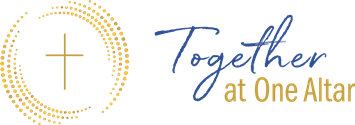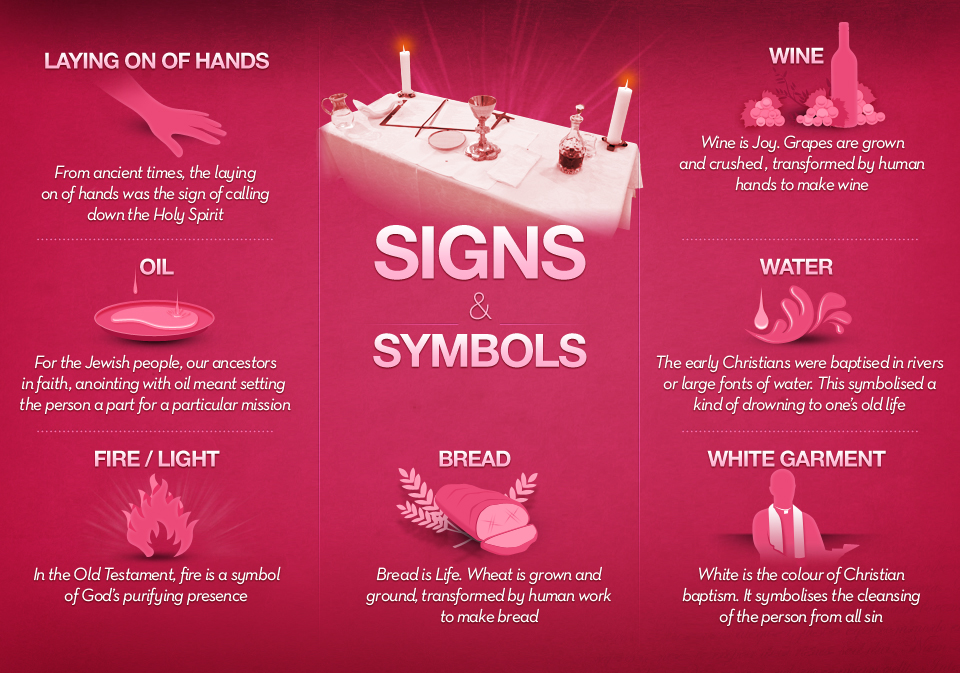SIGNS AND SYMBOLS
The signs and symbols used in the Church’s liturgy provide us with a great opportunity for reflection. These simple elements of everyday life invite us to reflect on the mystery of our faith.
Most of them are also found in our own homes: oil, bread, light, water, wine, and white clothing. They are simple, basic and very accessible to us. These simple elements of everyday life invite us to reflect on the mystery of our faith.
We need symbols that speak to us of the sacred.
In our present age we are confronted with so many flashing images and shrill sounds competing for our attention that we can end up feeling fragmented, because we have no time to reflect or to be still. We sometimes long for peace and a sense of calm.
One way to promote inner peace is to contemplate the meaning of a symbol, such as a flame or a simple bowl of clear water. A symbol is a little like a ‘window’ to God. It gives a glimpse into the mystery of the divine at the heart of life.
In the liturgy and in all sacraments simple elements from life are brought forward and made sacred. Light, water, clothing, oil, hands, bread and wine are transformed from ordinary objects into the gift of God’s grace and presence with us, and we too are transformed into images of Christ.
The ‘language’ of Symbols
As a Church we have a ‘language’ that helps us put expression to the moments of grace that mark our lives. This language is expressed in symbols and rituals (which are beyond words) and also, of course, in words that help us communicate the mystery of our relationship with the Divine. This is the language of the liturgy. Let’s look at a few of these symbols:
Laying on of Hands
One of the primary symbols in the liturgy is the ‘laying on of hands’. From ancient times, to impose hands on someone or to extend one’s hand over the person’s head was the sign of calling down the Holy Spirit. All seven sacraments employ this symbol. We call the prayer which accompanies the imposition of hands an epiclesis, which is an invocation. In the Eucharist, the priest stretches his hands over the bread and wine to call upon the Holy Spirit to consecrate these gifts into the body and blood of Christ.
Bread and Wine
Wheat is grown and ground, transformed by human work to make bread. Grapes are grown and crushed, transformed by human work to make wine. It is traditionally the work of human hands.
Bread is life. Wine is joy. The sharing of food and drink is often linked with peace-making and the resolution of differences. From the earliest times, human beings have shared meals together. The very act of eating and drinking together is a symbol of fellowship, common life, common love.
In biblical times, people ate everything from the same plate. People ate using flat bread which served as a ‘spoon’ dipped into the communal dish. Sharing food in this way increased the sense of solidarity and fellowship among those eating it. They became, in a sense, one body.
The breaking of the bread was the ritual gesture that established communion among those at table in a Jewish ritual meal. The Last Supper was such a meal. Jesus identified the broken bread and poured wine with his own Body and Blood, broken and poured out in his suffering and Death. After his Resurrection, Jesus’ disciples spoke of recognising him in the ‘breaking of the bread’. The ‘breaking of the bread’ eventually came to describe the whole action of the Eucharist after the time of Jesus.
Fire/Light
In the Old Testament, fire is a symbol of God’s purifying presence. In the biblical narratives we read of Moses before the burning bush, intensely aware of the presence of God. We read of the Hebrew people journeying through the desert, led by a pillar of fire by night. In the Bible, transformation is nearly always manifested by light, In the Old Testament, Moses is transfigured. In the New Testament, Jesus is transfigured, shining brighter than the sun. This ‘shining’ signifies the radiance of God’s presence. In the New Testament also, the flames of Pentecost are a symbol of the presence of God transforming the lives of Jesus’ disciples.
We too will be transformed. At Baptism we are given a lighted candle to symbolise the light of Christ. This is the transforming light of faith that drives out the darkness of despair. And we are commissioned to keep this light burning brightly throughout our lives.
Oil
For the Jewish people, our ancestors in faith, anointing with oil meant setting the person apart for a particular mission. Just as royalty and Priests are anointed for a particular mission, so are we as Christians given a particular mission to be Christ in the world today.
The word Christ means the Anointed.
We call ourselves Christians because we are anointed in Baptism. We are the community anointed to continue the work of Christ, the anointed one.
White Garment
The newly baptised are clothed in white as a symbol of ‘putting on’ Christ, and the pure new life of grace. White is the colour of Christian baptism. It symbolises the cleansing of the person from all sin. The earliest Christians wore white to signify their union with Christ and their commitment to living a virtuous life. At Mass, the Priest wears a white alb which represents his baptismal garment.
For Reflection and Discussion
1
All seven sacraments employ the symbol of the epiclesis, or ‘laying on of hands’. The word epiclesis means ‘invocation’ or ‘calling down from on high’. Explore the liturgical rites and identify the moment when this happens in each of the sacraments. Describe, in your own words, the power and meaning of this gesture.
2
There are three holy oils used in catholic sacraments:
1. the oil of catechumens,
2. the oil of chrism
3. the oil of the sick.
Explore the sacramental purpose for each of these oils. Identify the times in your own faith journey when you have been anointed? Which oil was used and why?
3
Compare and contrast the Scripture passages of Moses’ shining face (Exodus 34: 29–35) and Jesus’ transfiguration (Matthew 17: 1–8). Why do you think the presence of God is described in terms of brilliant light?
4
How is light used in Baptism? During the baptismal ceremony, what are the words that accompany the receiving of the light? Also identify the words prayed as the white garment is placed on the newly baptised person. How do these prayers describe the mission bestowed on the new Christian? How can Christians live that mission in today’s world?
5
Write a short reflection bringing your life, your work, your hopes and dreams to the Eucharist in order to be transformed in Christ.
Further Resources
WEBLINKS
BOOKS
Mitchell, Nathan D., Meeting Mystery: Liturgy, Worship, Sacraments, Orbis Books: Maryknoll, NY, 2006

